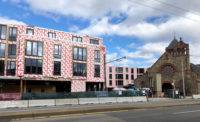Massachusetts Gov. Charlie Baker (R) on March 26 signed sweeping legislation that puts the state on the hook to slash carbon emissions to 50%—below 1990 levels—by 2030 on its way to “net zero” emissions by 2050. While praising the intent of the landmark climate change bill, groups representing state construction and development sectors had raised concerns about some bill provisions related to local energy and building codes, with changes made.
Under the newly passed law, state environment officials will hammer out plans for a more stringent series of building and energy codes than are currently on the books.
Once the new rules are complete, cities, towns and suburbs across the state will have the option of replacing their current energy codes, a subset of the overall building code, with the new, and tougher state-designed “stretch” energy code.
That new and improved code, in turn, is likely to raise the cost of building new labs, offices, homes and apartments, requiring more money to be spent on everything from insulation to the latest and most efficient HVAC systems.
Anastasia Nicolaou, vice president of policy and public affairs at NAIOP Massachusetts, said the final bill extended the deadline for the state to create a new stretch energy code to 18 months.
That was a significant concession, with the previous bill calling for the new code to be in place in a year, an insufficient amount of time for such a complex issue, Nicolaou contends.
The new law itself was the subject of complex, months-long legislative haggling that included a veto of an earlier version by Baker.
“We are really grateful the Legislature took steps to address some of the concerns of the business community,” NAIOP’s Nicolaou said.
The bill also calls for at least five public hearings on the new stretch energy code, in which industry groups like NAIOP and the Greater Boston Plumbing Contractors Association say they plan to take part and provide feedback to state regulators.
In addition, Boston’s efforts to involve industry stakeholders in developing its own net zero carbon building regulations, by forming a technical advisory panel, could provide a model for state regulators as well, Nicolaou said.
State legislative leaders also made other tweaks to the final climate change bill that helped assuage concerns of industry groups.
The plumbing contractors’ association was relieved to see that a requirement that the tougher new net zero energy stretch codes called for under the new climate change law will not become mandatory for all communities by 2028, as was the case in earlier drafts of the legislation, said Andrew DeAngelo director of public affairs for the Greater Boston Plumbing Contractors Association.
The state Board of Building Regulations and Standards, which oversees the current statewide building codes, will approve the new standards, something the plumbing contractors group also pushed for, DeAngelo noted.
The contractors’ group had been concerned the state Dept. of Energy Resources would have complete oversight, potentially leading to a new code “that was out of touch with reality” and that might even allow communities to ban natural gas hookups.
“We did not get everything we would have liked changed but we will now have a seat at the table in developing this code to make sure it makes practical and economic sense,” DeAngelo said.
Overall, the adoption of new and tougher stretch energy codes is expected to add cost to construction.
A project that previously would have cost $400 to $500 a square foot to build, might cost $525 a square foot, Greg Vasil, president and CEO of the Greater Boston Real Estate Board, has noted.
Even so, industry leaders say they understand the need to reduce carbon emissions.
Vasil noted his organization had supported a climate change bill passed by the House in 2019. “Everyone agrees we absolutely need to do something on climate change,” he said.






Post a comment to this article
Report Abusive Comment